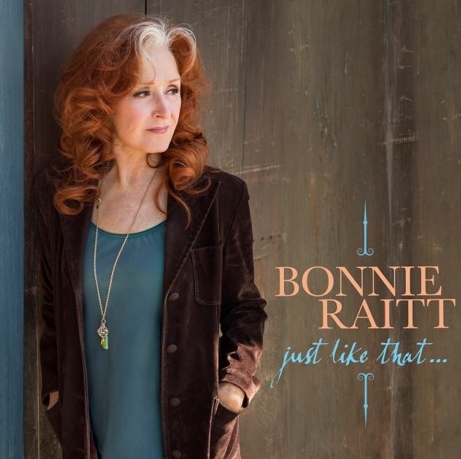Since finding out the other day that Bonnie Raitt was going to come out with a new album I had been full of anticipation. The wait was finally over last Friday (April 22). Not only is Just Like That… Raitt’s 21st album and her first new release in more than six years, but I increasingly feel it’s her best work to date in a 51-year recording career!
As people who follow this blog or are aware of my music taste otherwise know, Raitt is one of my long-time favorite artists. Since my former German bandmate and music buddy introduced me to Nick of Time in 1989, I’ve listened to this amazing lady. From the get-go, I loved her smooth slide guitar playing (btw, I read she’s completely self-taught!), as well her voice and songs. My appreciation increased even further after seeing Raitt at NJPAC in Newark, N.J. in August 2016. She’s just a phenomenal music artist!
According to Raitt’s website, work on Just Like That… began last summer when it appeared things with this tiresome pandemic were headed in a better direction, and she brought her band to Northern California: Duke Levine (guitar, vocals), George Marinelli (guitar, vocals), Glenn Patscha (keyboard, vocals), James “Hutch” Hutchinson (bass) and Ricky Fataar (drums). “I’ve always wanted to make a record here [closer to her home – CMM], and once vaccinations made traveling safe again, we were thrilled to get everyone back together,” she explained. “I think the absolute joy and relief of reuniting to play live music is really palpable on this record.”

“On this record, I wanted to stretch,” Raitt further pointed out. “I always want to find songs that excite me, and what’s different this time is that I’ve tried some styles and topics I haven’t touched on before.” Raitt has always had a gift to pick and interpret great songs written by other artists, such as John Hiatt, Gary Nicholson, Wayne Kirkpatrick and John Prine. Apart from continuing that tradition, Just Like That… also features four tunes written by Raitt – more than the usual two to three original songs on previous albums. Time for some music!
Here’s the great opener Made Up Mind, a song by Canadian roots-rock band The Bros. Landreth from their 2013 album Let It Lie. The song was co-written by David Landreth, Jonathan Singleton and Joseph Landreth. Raitt’s rendition was first released on February 22 as the first of three upfront singles. “Made Up Mind I fell in love with in 2014 from The Bros. Landreth who opened a show for us in Canada,” Raitt told Zane Lowe during a 1-hour interview for Apple Music. Can’t blame her. Here’s the excellent original in case you’re curious!
Something’s Got a Hold of My Heart is a tune by American guitarist and songwriter Al Anderson, who according to his AllMusic bio “is best known for his 22-year stint with roots-rock renegades NRBQ” [between 1971 and 1993 – CMM]. “Al Anderson I’ve been friends with, with one of my favorite bands, NRBQ,” Raitt told Zane. “He was the lead singer and guitar player for them, one of the lead singers. And I’ve had that song for 30 years.” Like Made Up Mind, the track first appeared as an upfront single, on March 25. Love this tune!
Since I included Livin’ For the Ones, another highlight of the album, in my last Best of What’s New installment, I’m skipping it here and go right to the title song. Written by Raitt, it’s a deeply touching story song inspired by a news story she had watched on TV. “They followed this woman who was going to the house of the man who received her son’s heart she donated when he passed away, for the first time,” Raitt told Zane. “…And he invited her to sit on the couch…And then he said, ‘would you like to put your head on my chest and listen to your son’s heart?’ [Raitt’s voice breaks] It laid me out. It just laid me out.” Just picturing the scene Raitt described makes you cry!
Things turn funky on Waitin’ For You to Blow, another original. According to a statement on Raitt’s website, the song is inspired by Mose Allison, Les McCann and Eddie Harris, and ‘70s funk. “There’s something thrilling about creating something brand new out of feelings and styles that have always run so deep in me,” Raitt stated. Check out the cool groove of that tune!
The last track I’d like to call out is Love So Strong, a song by Jamaican ska and rock steady group Toots and the Maytals from their 2007 album Light Your Light. The above statement notes Raitt had planned to do that tune as her third duet with the band’s frontman Toots Hibbert, but her dear friend passed away in 2020. Raitt ended up recording the groovy song as a tribute to Hibbert, who is regarded as a reggae pioneer like Bob Marley.
Bonnie Raitt produced Just Like That…. Like her two previous albums, Dig In Deep (2016) and Slipstream (2012), Just Like That… appears on Redwing Records. The album was recorded and mixed by Ryan Freeland who had served as engineer and mixer on the Grammy-winning Slipstream. Freeland has also worked with Ray LaMontagne, Aimee Mann, Loudon Wainwright III and Alana Davis, among others.
Here’s a Spotify link to the album:
The final word shall belong to Raitt who as stated on her website has never felt more grateful that she can continue making music, contributing to causes, keeping her crew working, and connecting with her audience. “I’m really aware of how lucky I am and I feel like my responsibility is to get out there and say something fresh and new—for me and for the fans,” she says. “It’s really daunting not to repeat yourself, but I have to have something to say, or I wouldn’t put out a record.”
Sources: Wikipedia; Bonnie Raitt website; Apple Music; AllMusic; Discogs; YouTube; Spotify





